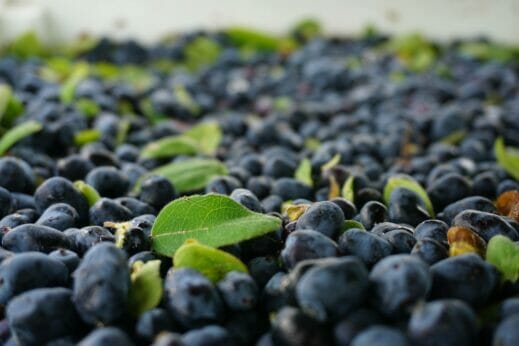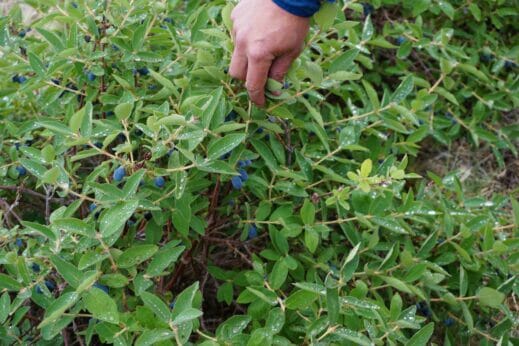Grown under the rays of the midnight sun, haskap berries are a rare agricultural export for Canada’s Yukon territory.

Agriculture is a tricky business in the Yukon. Bordering Alaska to the west, most of the landscape is tundra and northern boreal forest. Winters are long and very cold, with temperatures often dipping to below -40 degrees Celsius. Frosts can come as late as the end of May and return in mid-August. This makes the growing season short, a mere three months—if that. The main agricultural driver has traditionally been hay.
With only 88 farms producing just one percent of the fresh produce consumed locally, it’s not a choice but a necessity for food to be imported from the south. Until now. North of the capital Whitehorse, in the southernmost part of the territory, Yukon Berry Farms is growing 50,000 haskap berry plants on 50 acres.
In 2022, the farm yielded 15,000 pounds of berries, most of which will be turned into wine or cider and exported out of the territory—a rarity for the area, which is almost completely reliant on imported food.
It begs the question: How can haskaps be grown on such a massive scale, in such an inhospitable setting?

Photography courtesy of Yukon Berry Farms.
Haskaps, which look like an elongated blueberry and taste similar to a tart raspberry, grow wild in circumpolar regions throughout Canada, Asia and northern Europe. But very few people have heard of them.
“Wild haskaps are small and it takes a lot of picking to fill a bucket,” says Dr. Bob Bors, manager of the fruit program at the University of Saskatchewan. There, Bors has successfully hybridized more than 10 different varieties of haskaps, all suited for northern growing.
The idea of turning haskaps into a commercial crop first took seed in the 1950s. Canadian horticulturists hybridized a strain of haskap from wild plants and those commercially grown in Siberia. But it didn’t even make it to market. “That berry,” says Bors, “tasted like tonic water and fruit breeders saw no marketability in it.” Bors’ secret weapon was the sweet Japanese haskap, which he combined with the Canadian wild berry and Siberian cultivator to create a cold hardy plant, with a bigger, tastier fruit than earlier versions.
Now his berries are growing at Yukon Berry Farms. He’s not surprised at their success, especially with climate change causing warmer winters. In 2021, the lowest recorded temperature in Whitehorse was -45.5 degrees Celsuis. Further south in Abbotsford, the heart of British Columbia’s fertile berry-producing Fraser Valley, where mild winters are often the norm and spring comes early, the temperature barely dipped below -7 degrees Celsius.
“Haskaps love extended periods of deep, sub-zero cold,” says Bors. “In the south,they can wake up too earl, and flower before the bees and insects they rely on for pollination and ultimately fruit production have broken their hibernation.” Bors’ research also suggests that the heat typical of long southern summers could shut down the plant’s ability to grow and produce.
They’re also susceptible to humidity. “This can cause powdery mildew, a fungal disease, that damages the plant,” says Graham Gambles, secretary for the Haskap Berry Growers Association of Ontario. This makes Whitehorse’s dry climate (it receives less than 260 millimetres of rain, or 11 inches, annually) ideal for haskaps.

Photography courtesy of Yukon Berry Farms.
Kyle Marchuk, the co-owner of Yukon Berry Farms, knew how lucrative haskaps could be as an export crop from the moment he first encountered them.
“A friend of mine was growing haskaps on a small test plot, here in the Yukon, and they were producing more berries than on bushes being grown in the south. So many, in fact, that a buyer from outside of the Yukon was willing to buy all the berries that could be produced and export them out of the territory.”
It spurred Marchuk to become a partner in Yukon Berry Farms in 2014 and plant 20,000 haskaps. In 2016, at a food show in Tokyo, Japan, he showcased haskap berry jam and was amazed at the Japanese interest in the product. He knew then that haskaps could be a lucrative export market for Yukon growers.
By the end of 2018, Yukon Berry Farms had expanded operations and was growing more than 40,000 haskap bushes.

Photography courtesy of Yukon Berry Farms.
There are weeds that pop up between the plants and voles that eat the bark for food over the winter. “But the biggest challenge,” says Marchuk, “has been the changes the Canadian government made in 2019 to export licensing of fresh food.”
The Canadian Food Inspection Agency’s (CIFA) new regulations meant growers such as Marchuk would be required to do more paperwork and be subject to more inspections. The process was more time consuming than it had been and the licensing more expensive, so instead of exporting raw berries and jam, Marchuk and his partners opened Yukon’s first winery and cidery.
“The laws surrounding the export of alcohol are more lenient. We’re exporting haskap wine and cider to Japan and planning to get products into stores across Canada very soon,” he says.
Taking three to four years to reach maturity, each haskap bush can yield up to 10 pounds of berries a season—enough to share with the world and the local community, says Carl Burgess, executive director of the Yukon Agricultural Association. He sees no reason why haskap berries grown in the Yukon can’t be exported. “We have tomatoes from Mexico imported to the Yukon, so why not locally grown haskaps exported to Mexico?”
My sister here in Winnipeg MB has a couple of bushes and man..talk about berries. The last couple of summers we’ve had high humidity and I’ve never seen any mildew on them.
Bumper crop on my u-pick berry farm at Mackenzie, BC. Will plant my 7th haskap variety this fall, about 60. I have 700 plants in the ground already.